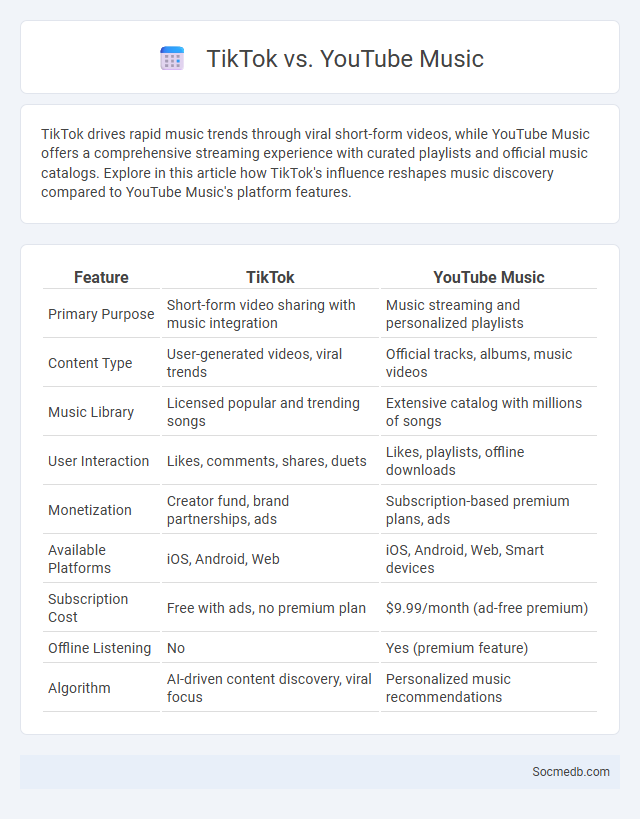
Photo illustration: TikTok vs YouTube Music
TikTok drives rapid music trends through viral short-form videos, while YouTube Music offers a comprehensive streaming experience with curated playlists and official music catalogs. Explore in this article how TikTok's influence reshapes music discovery compared to YouTube Music's platform features.
Table of Comparison
| Feature | TikTok | YouTube Music |
|---|---|---|
| Primary Purpose | Short-form video sharing with music integration | Music streaming and personalized playlists |
| Content Type | User-generated videos, viral trends | Official tracks, albums, music videos |
| Music Library | Licensed popular and trending songs | Extensive catalog with millions of songs |
| User Interaction | Likes, comments, shares, duets | Likes, playlists, offline downloads |
| Monetization | Creator fund, brand partnerships, ads | Subscription-based premium plans, ads |
| Available Platforms | iOS, Android, Web | iOS, Android, Web, Smart devices |
| Subscription Cost | Free with ads, no premium plan | $9.99/month (ad-free premium) |
| Offline Listening | No | Yes (premium feature) |
| Algorithm | AI-driven content discovery, viral focus | Personalized music recommendations |
Introduction: The Rise of Short-Form and Long-Form Music Platforms
The rise of short-form and long-form music platforms has transformed how You discover and engage with music, offering quick access to trending tracks alongside immersive, extended listening experiences. Short-form platforms like TikTok boost viral hits through brief, catchy clips, while long-form services such as Spotify and Apple Music provide curated playlists, full albums, and podcasts for deeper musical exploration. This dual landscape shapes music consumption by catering to varied preferences and expanding artists' reach globally.
TikTok and YouTube Music: Platform Overviews
TikTok revolutionizes content discovery with its AI-driven For You Page, delivering personalized, short-form videos that engage millions globally. YouTube Music offers an extensive library of official tracks, live performances, and user-generated content, providing users seamless integration with Google services and personalized playlists. Your digital entertainment experience benefits from TikTok's viral trends and YouTube Music's diverse audio options, making both platforms essential for content consumption and music streaming.
User Demographics: Who’s Listening and Watching?
Social media platforms attract diverse user demographics, with Millennials and Gen Z dominating Instagram and TikTok, while Baby Boomers and Gen X show higher engagement on Facebook. You can tailor your content strategy by analyzing age, gender, location, and interests to target audiences effectively and boost engagement. Understanding these demographic insights is essential for maximizing reach and enhancing your brand's social media presence.
Music Discovery: Algorithms and Viral Trends
Social media platforms utilize advanced algorithms that analyze Your listening habits and interactions to personalize music discovery, ensuring tailored recommendations. Viral trends on apps like TikTok significantly influence chart-topping hits by rapidly amplifying emerging artists and songs. These dynamic systems combine user data with real-time engagement to shape the evolving landscape of music consumption.
Artist Interactions and Promotion Strategies
Artists leveraging social media platforms such as Instagram, TikTok, and Twitter engage audiences through live sessions, behind-the-scenes content, and interactive Q&A, enhancing fan loyalty and visibility. Strategic use of targeted hashtags, collaborations with influencers, and scheduled posts maximize reach and engagement, driving music streams and event attendance. Data analytics tools empower artists to refine promotion strategies by tracking audience demographics, peak activity times, and content performance metrics.
Content Formats: Short Clips vs. Full Tracks
Short clips on social media generate higher engagement due to their quick consumption and shareability, ideal for capturing audience attention in seconds. Full tracks provide a deeper connection with listeners, allowing artists to showcase their style and encourage longer listening sessions. Balancing both formats leverages the strengths of viral exposure and sustained audience retention for effective digital music marketing.
Monetization Models: Creators and Revenue Streams
Social media platforms utilize diverse monetization models enabling creators to generate revenue through advertising partnerships, sponsored content, subscriptions, and fan donations. Revenue streams also include platform-specific features such as YouTube's Super Chat, TikTok's Creator Fund, and Instagram's branded content tools. These models empower creators to diversify income while platforms benefit from increased engagement and ad revenue.
Platform Relevancy in 2024: Engagement and Influence
Platform relevancy in 2024 hinges on algorithms prioritizing authentic user interactions and niche community engagement, driving higher influence and content visibility. Social media channels like TikTok and Instagram continue to dominate with their focus on short-form video, while LinkedIn's rise in professional networking enhances thought leadership opportunities. Understanding these platforms' unique engagement metrics allows you to tailor your content strategy effectively, maximizing reach and audience impact.
Accessibility and Global Reach Comparison
Social media platforms prioritize accessibility through features like screen readers, captions, and adjustable font sizes, enabling users with disabilities to engage fully. Global reach is unmatched, with billions of active users connecting across continents instantly, expanding Your brand influence beyond traditional boundaries. Choosing platforms with comprehensive accessibility tools maximizes inclusivity and engagement worldwide.
Conclusion: Which Platform Holds the Future of Music Consumption?
TikTok dominates the future of music consumption due to its powerful algorithm that drives viral trends and boosts new artists' visibility swiftly. Spotify remains a key platform by combining personalized playlists, extensive libraries, and integrated social features to foster music discovery and sustained engagement. Emerging platforms integrating augmented reality and blockchain technology are poised to reshape the landscape, but TikTok and Spotify currently lead the evolution of how audiences experience music.
 socmedb.com
socmedb.com